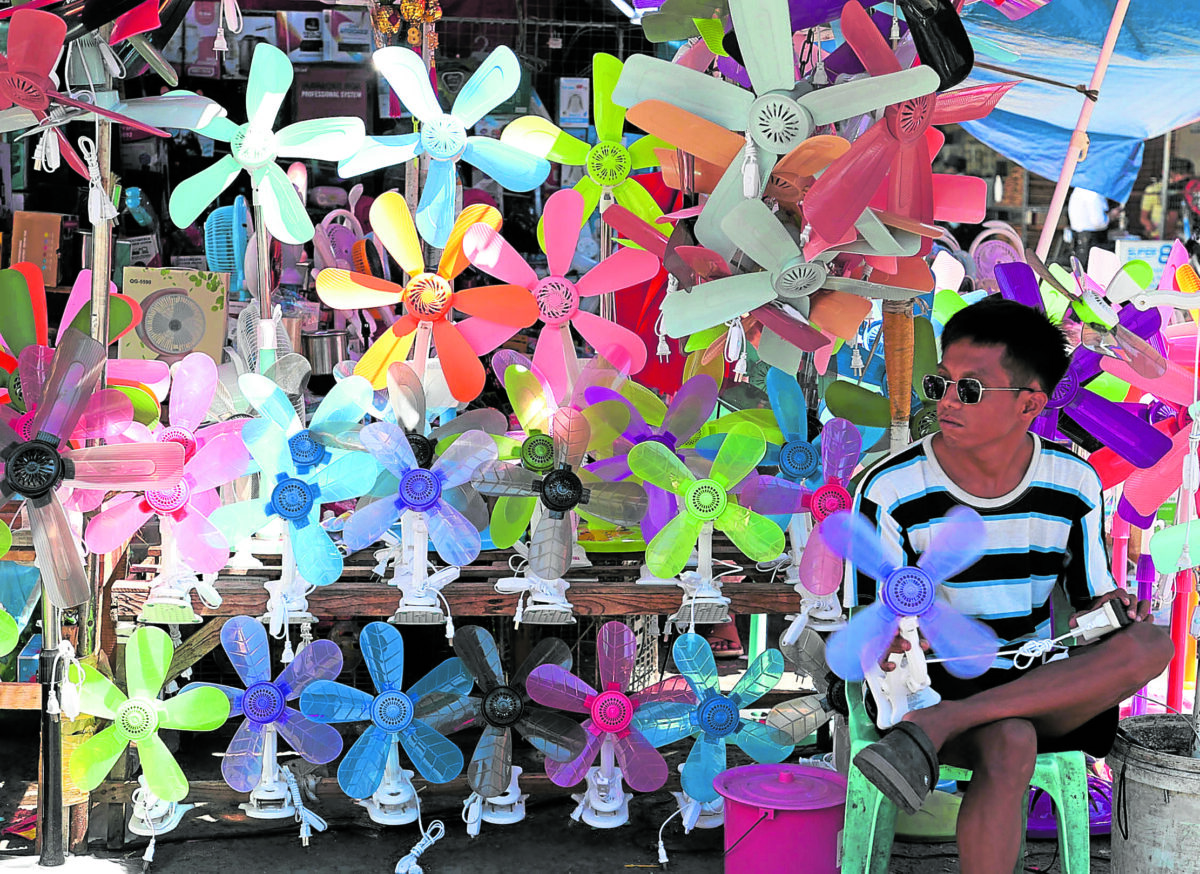
HEAT BUSTERS Portable electric fans sell from P150 to P250
in Alabang, Muntinlupa, as people look for different ways to
cool off. The weather bureau, however, warns of hotter days
ahead. —MARIANNE BERMUDEZ
MANILA, Philippines — Roxas and Zamboanga cities are forecast to experience a heat index of 45 degrees Celsius on Tuesday, April 23, the Philippine Atmospheric, Geophysical and Astronomical Services Administration (Pagasa) said.
“Danger” level of sizzling temperatures were also predicted for 23 other areas of the country, such as:
- Dagupan City, Pangasinan – 44 degrees Celsius
- Puerto Princesa City, Palawan – 44 degrees Celsius
- Aborlan, Palawan – 44 degrees Celsius
- Virac (Synop), Catanduanes – 44 degrees Celsius
- Central Bicol State University of Agriculture in Pili, Camarines Sur – 44 degrees Celsius
- Sangley Point, Cavite – 43 degrees Celsius
- Central Luzon State University in Muñoz, Nueva Ecija – 43 degrees Celsius
- San Jose, Occidental Mindoro – 43 degrees Celsius
- Iloilo City, Iloilo – 43 degrees Celsius
- Guiuan, Eastern Samar – 43 degrees Celsius
- Dipolog, Zamboanga del Norte – 43 degrees Celsius
- Cotabato City, Maguindanao – 43 degrees Celsius
- Butuan City, Agusan del Norte – 43 degrees Celsius
- Ninoy Aquino International Airport, Pasay City – 42 degrees Celsius
- Aparri, Cagayan – 42 degrees Celsius
- Clark International Airport, Pampanga – 42 degrees Celsius
- Barangay Ambulong in Tanauan, Batangas – 42 degrees Celsius
- Infanta, Quezon – 42 degrees Celsius
- Coron, Palawan – 42 degrees Celsius
- Daet, Camarines Norte – 42 degrees Celsius
- Masbate City, Masbate – 42 degrees Celsius
- Davao City, Davao del Sur – 42 degrees Celsius
- Dumangas, Iloilo – 42 degrees Celsius
READ: LIST: Suspended on-site classes on Tuesday, April 23
Pagasa previously said that heat indices ranging from 42 to 51 degrees Celsius fall under the “danger” category as such high temperatures could cause heat cramps, exhaustion, and even heat stroke with prolonged exposure.
The state weather bureau defines heat index as “a measure of the contribution that high humidity makes with abnormally high temperatures in reducing the body’s ability to cool itself.”
READ: Scorching heat: PH bearing the burden of climate crisis
To prevent the effects of searing weather, Pagasa said the public must limit time spent outdoors; drink plenty of water; avoid tea, coffee, soda, and liquor; use umbrellas, wear hats, and wear sleeved clothing outdoors; and schedule heavy-duty activities on the cooler periods of the day.
It noted that symptoms of heat-related illnesses include heavy sweating, exhaustion or fatigue, dizziness or lightheadedness, blacking out or feeling dizzy when standing, a weak but fast pulse, nausea, and vomiting.
In cases of emergency, Pagasa advised the public to do the following:
- Move the person to a shady spot and lie him or her down with legs elevated
- If conscious, have them sip cool water
- Remove clothing, apply cool water to the skin and provide ventilation
- Apply ice packs to the armpits, wrists, ankles, and groin
- Bring to a hospital immediately